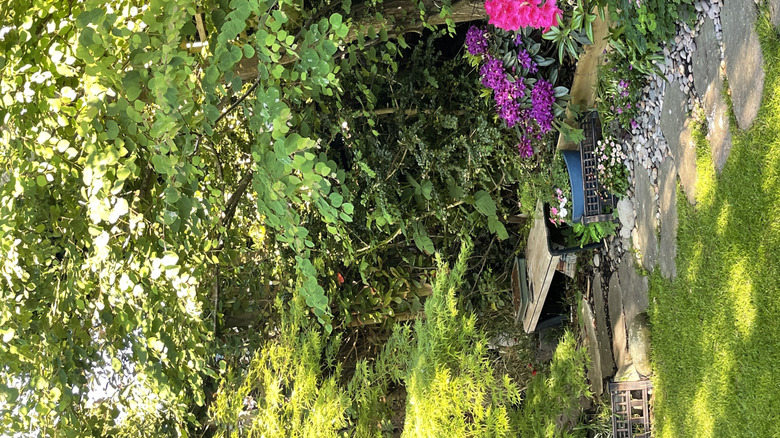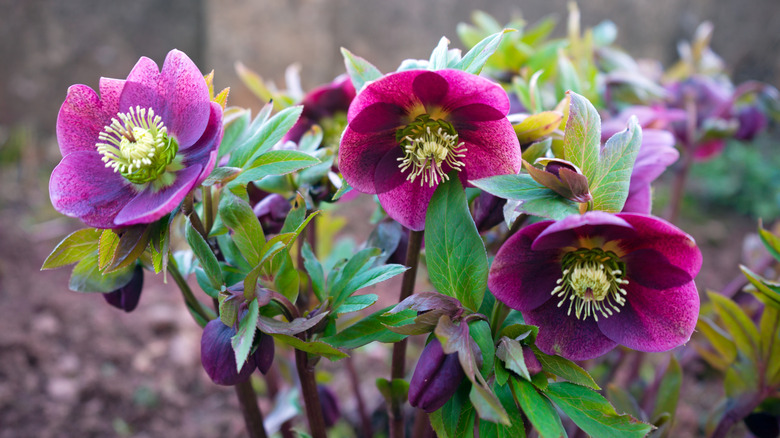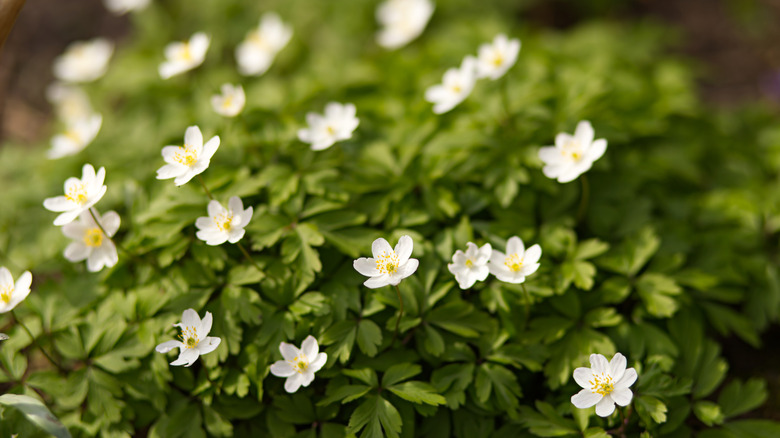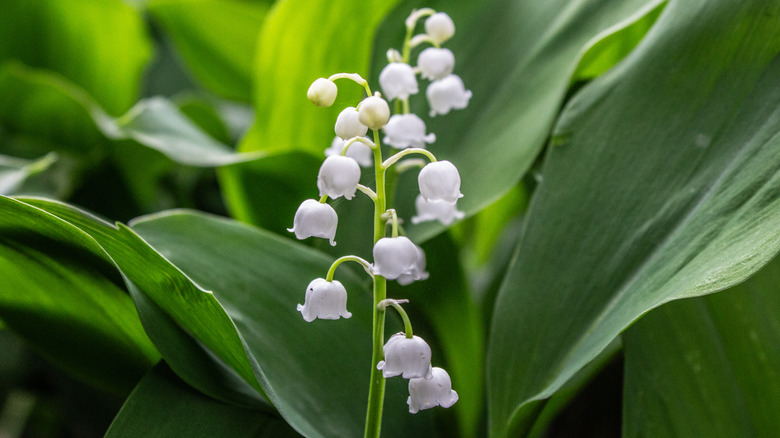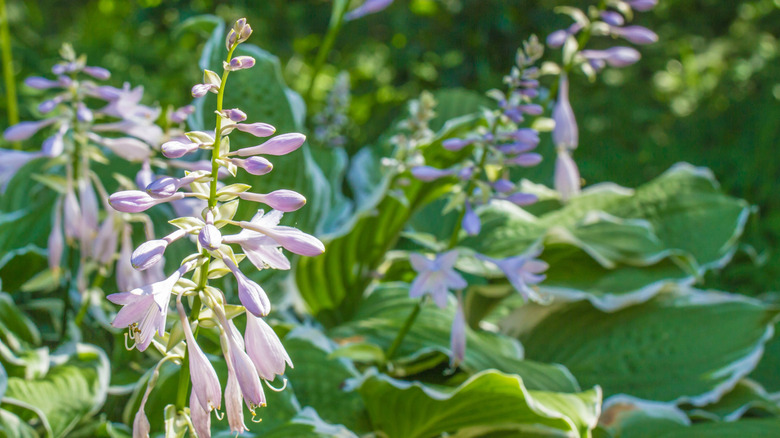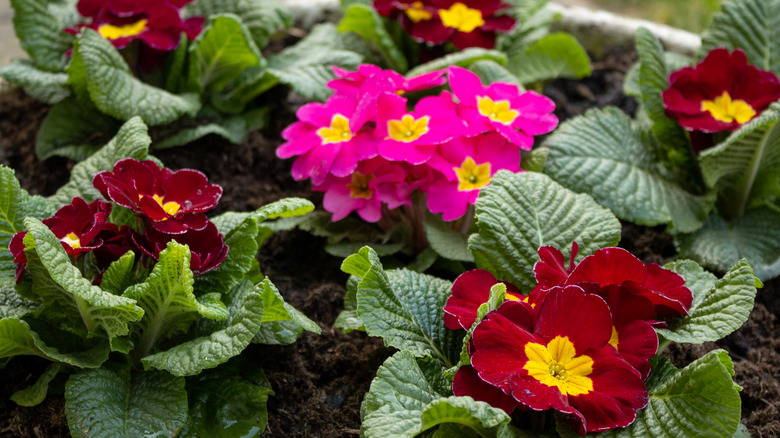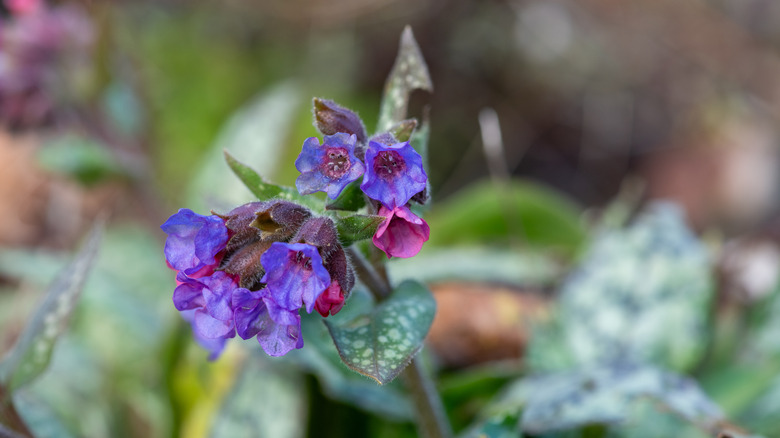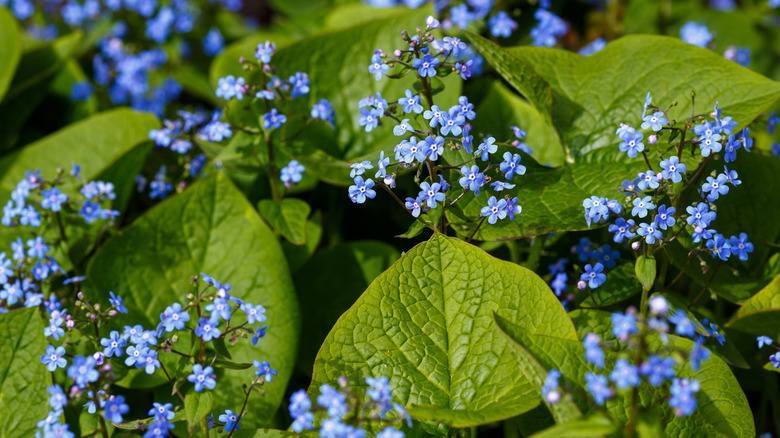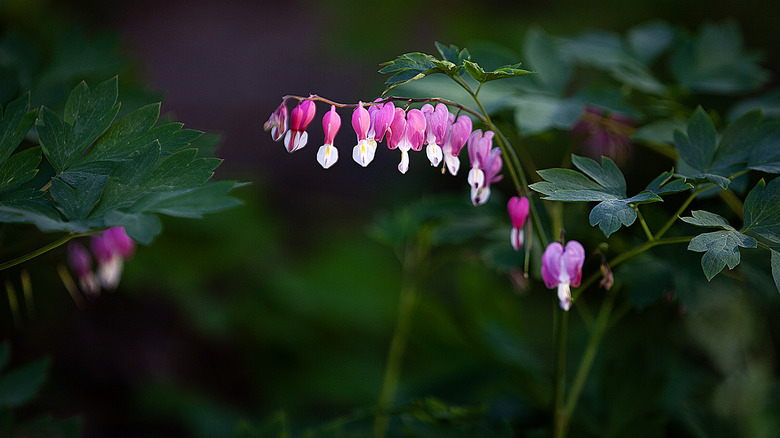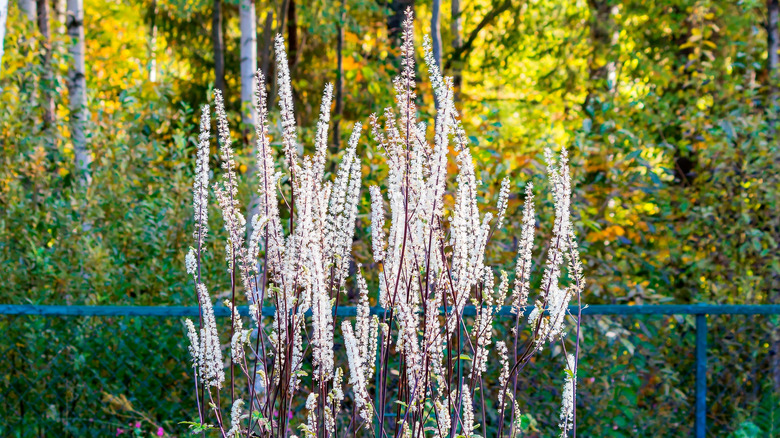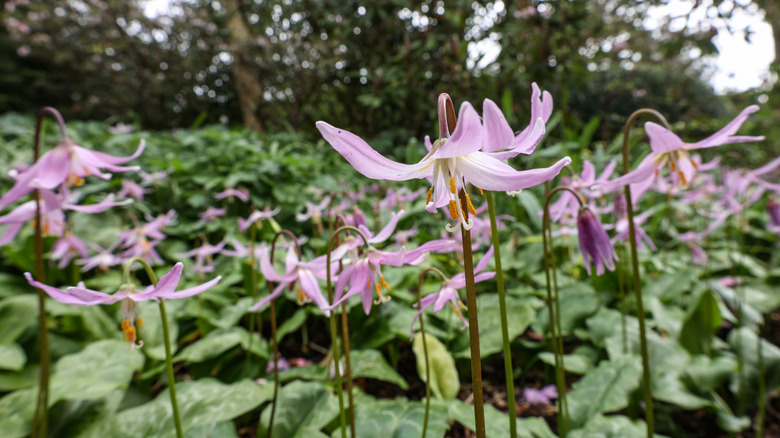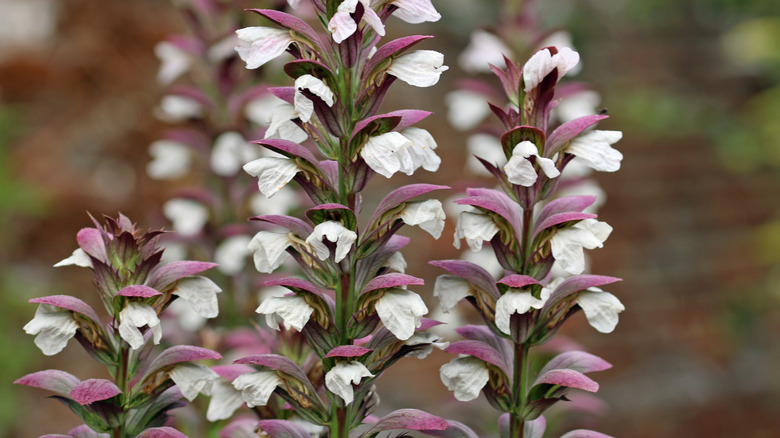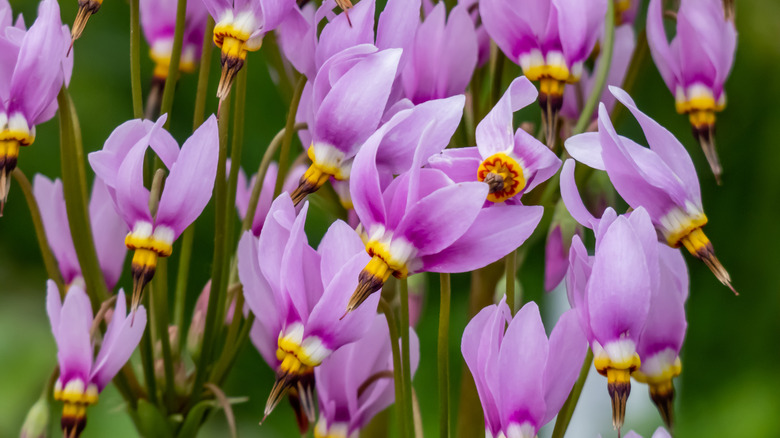12 Shade-Loving Flowers To Plant In October For Bursting Color Next Spring
There's nothing quite like walking out on your patio in the spring and being greeted with the fresh scent of flowers and bright, colorful blooms busting through from the bare branches of winter. But if you have a shaded backyard, it can feel like your options for spring blooms are limited. After all, many garden favorites thrive in full sun. If you've felt this way before, you will be happy to know that there are plenty of fast-growing shade plants that will effortlessly fill your garden with color. Plus, you can plant many of them, like wood anemone, primrose, toad lily, and more, in October for blooms as early as next spring!
Cold-hardy perennials that grow in either partial shade or full shade, such as hellebores and bleeding hearts, do exceptionally well when planted in October because fall planting allows them to establish a root system all through the winter so they are ready to bloom by spring. However, you will need to pay attention to your climate and frost dates to make sure your October plants will survive through the winter. Some plants will need to be placed in the ground several weeks before the first frost, while others may do better being planted closer to the frost date. Here's what you need to know about 12 shade-loving flowers that should be planted in October for colorful spring blooms.
Hellebores
Hellebores (Helleborus) are cold-hardy perennials that can be planted in October in USDA Hardiness Zones 3 to 9. Fall is the best time to get your hellebores in the ground so you can enjoy these gorgeous, long-living perennials for years to come. They can do well in partial shade or full shade with blooms in late winter and early spring if planted in a location protected from high winds. In addition, they prefer moist, well-draining soil and will not do well in dry conditions, which is part of what makes October a great month for planting.
Wood anemone
Wood anemone (Anemonoides quinquefolia), also known as wind flower, is an herbaceous perennial that is commonly grown as a ground cover in zones 3 to 8. It can be planted in any shade conditions, ranging from full shade to dappled sunlight, so it is perfect for any type of shade garden. Wood anemone needs at least three months of cold after planting before it can germinate, making October a perfect time to plant. Then, it takes up to three months to start blooming, leaving you with delicate, white ground cover that comes to life sometime in early spring.
Lily of the valley
Lily of the valley (Convallaria majalis) is another herbaceous perennial that is commonly grown as a ground cover in zones 3 to 7. This white flower grows well in any shade conditions and blooms in spring. However, unlike wood anemone, lily of the valley has a long bloom season that extends into summer, though the flowers only appear for three weeks. They can be planted in cooler seasons, generally fall or spring, but if you are looking for blooms next spring, October is a great time to get them in the ground.
Hosta
Hostas are a great perennial to plant in shade gardens because they work as a companion plant that provides benefits to other flowers in the area while also acting as a ground cover. While they are known for their foliage, there is a wide range of hosta varieties that grow both striking leaves and flowers. When planted in October in zones 3 to 9, they will add color to your garden in spring as the foliage grows and then produce flowers by late spring or early summer.
Primrose
Fall is one of the best times to plant primrose (Primula), but there are several different varieties, so it is important that you refer to the guidance for your chosen variety. Many varieties are perennials that grow in zones 3 to 8, but some grow as annuals. All varieties like cooler temperatures and shade with blooms in the spring, though some may have longer blooming seasons for color through all seasons. If you are in a colder climate with harsh winters, you may need to protect them with cold frame gardening through the winter.
Lungwort
Lungwort (Pulmonaria officinalis) is another shade-loving perennial that is grown as a ground cover in zones 3 to 8. This is a spreading plant that blooms in showy clusters in the spring when planted in the fall. Plus, it grows well next to hostas. Depending on your zone, October is an ideal time to get your lungwort into the ground. A good rule of thumb is to plant at least four weeks before the first frost. This allows the plant to become established before winter.
False forget-me-nots
False forget-me-nots (Brunnera macrophylla) are a great addition to shade gardens if you want something with a long blooming season. They are called false forget-me-nots because they closely resemble the forget-me-not plant, but they are not in the same family. This clumping perennial grows in zones 3 to 8 and starts blooming in the spring. Fall is an ideal time to plant, but pay attention to frost dates when planting in October, because they need time to establish before a hard frost.
Bleeding hearts
Bleeding hearts (Lamprocapnos spectabilis) may be one of the most well-known shade-loving perennials due to their highly sought-after deer repellent qualities and showy blooms. These beautiful hanging blooms grow in zones 3 to 9. They are great for planting in the fall because you don't need to be too concerned about the frost date, so October works for both warmer and cooler climates. Plus, they need time in the cold to germinate, so planting in the fall means less preparation in the spring. When they bloom in the spring, it generally means the end of winter.
Black cohosh
Black cohosh (Actaea racemosa) bloom season begins in the late spring, so you can plant this shade-loving perennial in October for spring color. It grows best in zones 3 to 8 when planted before the ground freezes in the fall. Despite the name, black cohosh produces white flowers in neat clusters on tall spikes that can reach up to 7 feet. It produces blooms in any shade conditions, but will not do well in sustained sunlight.
Trout lily
Trout lily (Eurythronium) is a ground cover that grows best in zones 3 to 8. This shade-loving perennial pops up in small patches about 6 inches wide by 6 inches high. It produces yellow or pink blooms in the spring and is best planted in the fall before the first frost, though you may not see flowers for a few years. Depending on your climate, October may be the perfect time to get the bulbs in the ground before it freezes. More important than timing, however, is getting them in the ground immediately before they dry out.
Bear's breeches
Bear's breeches (Acanthus spinosus) is a stunning spiked flower that can grow in full sun or full shade, and is a hardy perennial in zones 7 to 10. They come in a wide range of colors that will bloom in the spring when planted in the fall. October is a good time to plant because of the cooler temperatures and extra moisture in the soil. This gives them time to establish a root system before the winter. They can also add height to the garden with blooms that reach up to 4 feet in the spring and summer.
Shooting star
If you're looking for flowering plants you can grow in cloudy climates, you should consider the shooting star (Dodecatheon). It is an herbaceous perennial in zones 4 to 8 that produces showy blooms in the spring, no matter how shady or cloudy it is. You can absolutely plant it in October to get blooms next spring as long as you plant divisions. Planting seeds in notoriously difficult and can take years to produce blooms. A general rule of thumb is to get it in the ground at least four weeks before the first hard frost.
